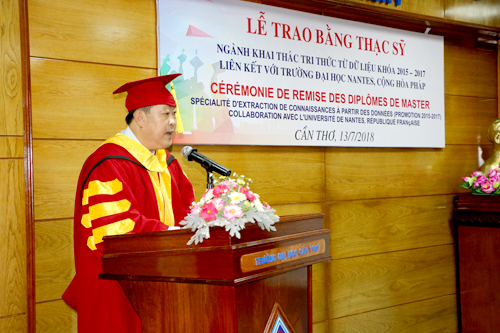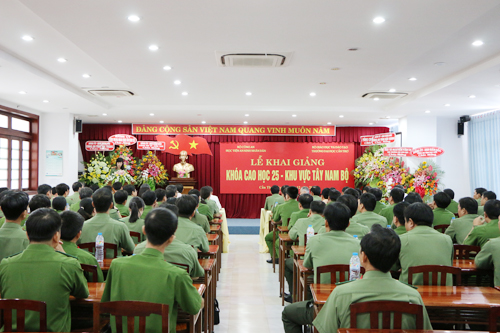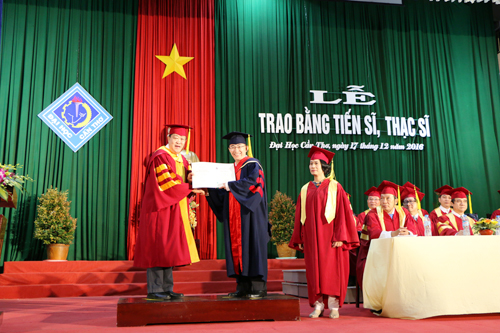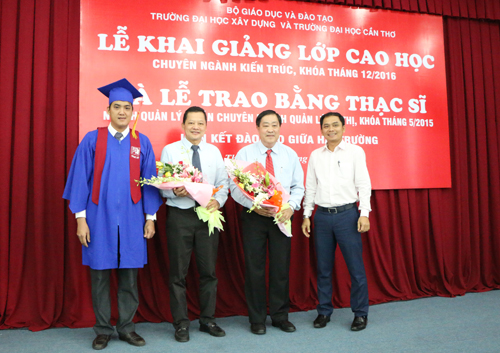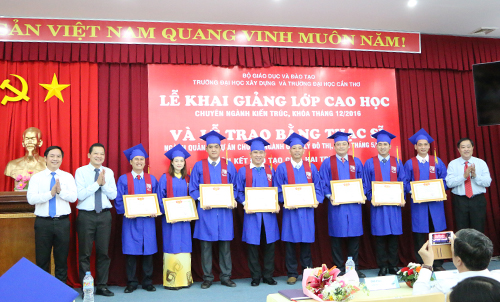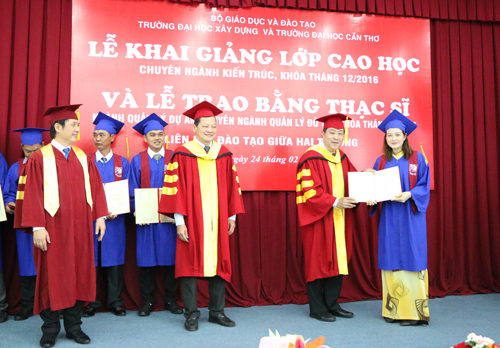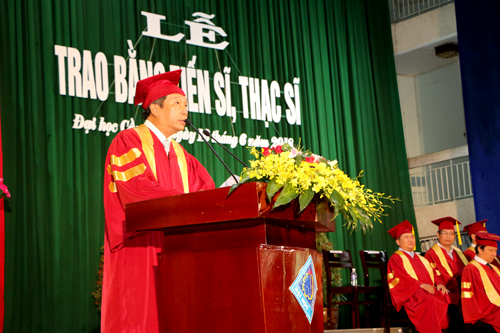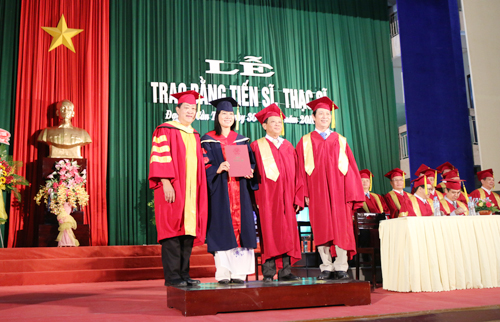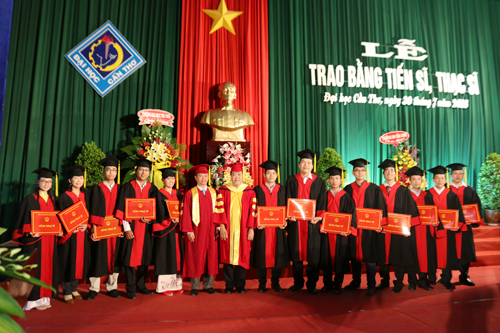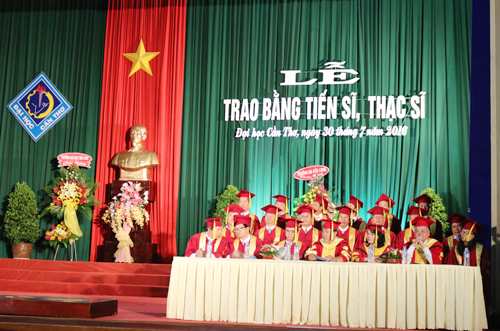
 Tên đề tài: “Nâng cao hiệu quả sản xuất mô hình nuôi tôm nước lợ ở vùng ven biển tỉnh Sóc Trăng”.
Tên đề tài: “Nâng cao hiệu quả sản xuất mô hình nuôi tôm nước lợ ở vùng ven biển tỉnh Sóc Trăng”.
 Tác giả: Trần Ngọc Tùng, Khóa: 2011
Tác giả: Trần Ngọc Tùng, Khóa: 2011
 Chuyên ngành: Kinh tế nông nghiệp; Mã số: 62620115. Nhóm ngành: Nông, lâm nghiệp và thuỷ sản.
Chuyên ngành: Kinh tế nông nghiệp; Mã số: 62620115. Nhóm ngành: Nông, lâm nghiệp và thuỷ sản.
 Người hướng dẫn chính: PGS.TS. Bùi Văn Trịnh - Trường Đại học Cần Thơ.
Người hướng dẫn chính: PGS.TS. Bùi Văn Trịnh - Trường Đại học Cần Thơ.
- Tóm tắt nội dung luận án
Luận án này được thực hiện nhằm phân tích các yếu tố ảnh hưởng đến năng suất, lợi nhuận và phân tích hiệu quả kỹ thuật và hiệu quả kinh tế của nông hộ nuôi tôm nước lợ. Từ đó phát hiện những hạn chế cần thiết phải cải thiện để nâng cao hiệu quả nuôi tôm nước lợ, thông qua đó đề xuất giải pháp nâng cao hiệu quả sản xuất mô hình nuôi tôm nước lợ vùng ven biển tỉnh Sóc Trăng, góp phần nâng cao thu nhập cho nông hộ nuôi tôm nước lợ tỉnh Sóc Trăng.
Số liệu thứ cấp của luận án được thu thâp từ niêm giám thống kê, Sở Nông nghiệp và PTNT, Sở Công thương, tỉnh Sóc Trăng. Số liệu sơ cấp phỏng vấn trưc tiếp nông hộ nuôi tôm nước lợ, với 310 quan sát. Nghiên cứu này sử dụng hàm sản xuất biên ngẫu nhiên (SFA) Cobb-Douglas để phân tích các yếu tố ảnh hưởng đến năng suất và hàm lợi nhuận biên ngẫu nhiên để phẩm tích ảnh hưởng của giá cả các yếu tố đầu vào đến lợi nhuận mô hình nuôi tôm thẻ chân trắng thâm canh, tôm sú thâm canh và tôm sú quảng canh cải tiến. Đây là hàm sản xuất được sử dụng phổ biến nhất trong kinh tế sản xuất (Meeusen và Van Den Broeck, 1977; Ali et al, 1989; Ali et al, 1994; Ahaman, 2003; Abu et al, 2011; Phạm Lê Thông, 2015; Nguyễn Hữu Đặng, 2017).
- Những kết quả mới của luận án:
Phát triển nuôi tôm nước lợ tại vùng ven biển tỉnh Sóc Trăng trong thời gian qua ổn định về diện tích, sản lượng không ngừng tăng lên, thị trường tiêu thụ ổn định và phát triển. Tuy nhiên, nghề nuôi tôm vẫn còn tồn tại một số hạn chế như diện tích thiệt hại chiếm tỷ lệ lớn, giá vật tư đầu vào tăng cao, giá tôm nguyên liệu không ổn định, môi trường vùng nuôi bị ô nhiễm, tôm nguyên liệu nhập khẩu của tỉnh chiếm tỷ lệ ngày càng cao, đây là điều mà địa phương cần quan tâm, tìm nguyên nhân, có giải pháp điều chỉnh kịp thời nếu không sẽ ảnh hưởng rất lớn đến quá trình sản xuất, tiêu thụ tôm nguyên liệu của tỉnh.
Năng suất tôm nuôi nước lợ đạt trung bình 2.287,37 kg/ha. Doanh thu đạt 328,42 triệu đồng/vụ/ha, chi phí sản xuất 215,39 triệu đồng/vụ/ha. Lợi nhuận đạt 113,02 triệu đồng/vụ/ha. Đây được xem là mức năng suất, doanh thu, lợi nhuận tương đối thấp hơn so với các nghiên cứu trước đây. Bên cạnh đó, giá thành sản xuất tương đối cao. Nông hộ không chủ động được thời gian thu hoạch, chỉ thu hoạch vào thời điểm tôm gặp rủi ro, tiêu thụ sản phẩm chưa qua hình thức hợp đồng, liên kết sản xuất, bán sản phẩm qua cấp trung gian, thông tin giá cả thị trường vật tư đầu vào và đầu ra nông hộ chưa nắm bắt kịp thời.
Mô hình nuôi tôm thẻ chân trắng thâm canh: có 4 hệ số yếu tố ảnh hưởng tích cực đến năng suất gồm hệ số biến chi phí sửa thiết bị, dụng cụ, giống thả nuôi, thức ăn, nhiên liệu. Và hệ số yếu tố ảnh hưởng tích cực đến lợi nhuận gồm hệ số biến chi phí sửa thiết bị, dụng cụ thuốc thú ý, hóa chất và nhiên liệu, tuy nhiên, hệ số yếu tố giá chuẩn hóa thức ăn ảnh hưởng tiêu cực đến lợi huận. Có 29,40% và 99,41% sự biến động của năng suất và lợi nhuận là do mức độ phi TE và phi EE. TE trung bình đạt 88,99% và EE trung bình 58,44%, không có nông hộ nào đạt TE, EE tối đa. Các yếu tố ảnh hưởng đến TE gồm diện tích mặt nước nuôi, mật độ nuôi, thời gian nuôi và tỷ lệ sống và các yếu tố ảnh hưởng đến EE gồm mật độ nuôi, thời gian nuôi và tỷ lệ sống.
Mô hình nuôi tôm sú thâm canh: các yếu tố ảnh hưởng tích cực đến năng suất nuôi gồm hệ số yếu tố số lượng giống, số lượng thức ăn và thuốc thú y, hóa chất. Và yếu tố ảnh hưởng đến lợi nhuận gồm hệ số của biến giá chuẩn hóa thức ăn, chi phí nhiên liệu. Có 86,79% và 59,72% sự biến động của năng suất và lợi nhuận của nông hộ là do mức độ phi TE và phi EE. TE trung bình đạt 91,73% EE trung bình đạt 70,71%, không có nông hộ nào đạt TE, EE tối đa. Các yếu tố ảnh hưởng đến tích cực đến TE gồm yếu tố lao động, tỷ lệ sống và các yếu tố ảnh hưởng tích cực đến EE gồm hệ số yếu tố kinh nghiệm, mật độ nuôi, thời gian và tỷ lệ sống, hệ số biến nguồn thông tin tác động tiêu cực đến EE.
Mô hình nuôi tôm sú quảng canh cải tiến: các yếu tố ảnh hưởng tích cực đến năng suất gồm hệ số yếu tố số lượng giống, số lượng thức ăn và nhiên liệu. Và các yếu tố có hệ số ảnh hưởng đến EE gồm yếu tố lao động, chuẩn hóa thức ăn và nhiên liệu, nhưng chỉ có hệ số biến nhiên liệu ảnh hưởng tích cực đến lợi nhuận. Có 20,94% và 43,13% sự biến động của năng suất và lợi nhuận là do mức độ phi TE và EE. TE trung bình 94,24% và EE trung bình 60,99%, không có nông hộ nào đạt TE và EE tối đa. Yếu tố ảnh hưởng tích cực đến TE chỉ có yếu tố tỷ lệ sống và các yếu tố ảnh hưởng đến EE gồm hệ số biến kinh nghiệm, diện tích mặt nước nuôi, nguồn thông tin, mật độ nuôi, thời gian và tỷ lệ sống.
- Các ứng dụng/khả năng ứng dụng trong thực tiễn, các vấn đề cần tiếp tục nghiên cứu:
Kết quả phân tích thực trạng sản xuất, tiêu thụ, phân tích các yếu tố ảnh hưởng đến năng suất, lợi nhuận và phân tích hiệu quả kỹ thuật và hiệu quả kinh tế của nông hộ nuôi tôm nước lợ. Và giải pháp nâng cao hiệu quả sản xuất mô hình nuôi tôm nước lợ vùng ven biển tỉnh Sóc Trăng, là cơ sở khoa học quan trọng đối với các cơ qua chuyên môn và lãnh đạo ngành nông nghiệp tỉnh Sóc Trăng.
Luận án là tài liệu tham khảo hữu ích phục vụ cho quá trình đào tạo các chuyên ngành Kinh tế nông nghiệp và Phát triển nông thôn ở bậc đại học và sau đại học..
- Summary of the dissertation
This dissertation was conducted to analyze the factors affecting the productivity and profitability and to analyze the technical efficiency and economic efficiency of brackish water shrimp farming households, thereby identify the limitations and issues that need to be improved in brackish water shrimp farming, suggest solutions to improve the productivity of brackish water shrimp farming in coastal area of Soc Trang province, and contribute to raising increasing the income of brackish water shrimp farming households.
Secondary data of the thesis was collected from the statistical yearbook, Department of Agriculture and Rural Development and the Department of Industry and Trade of Soc Trang province. Primary data was collected through direct interviews with brackish water shrimp farmers, with 310 observations. This research used the Cobb-Douglas stochastic frontier production function (SFA) to analyze the factors affecting the yield and stochastic frontier profit function to determine the effect of the prices of the inputs on the profit of the intensive whiteleg shrimp farming, intensive black tiger shrimp farming, and improved intensive black tiger shrimp farming models. This is the most commonly used production function in production economics (Meeusen and Van Den Broeck, 1977; Ali et al., 1989; Ali et al., 1994; Ahaman, 2003; Abu et al., 2011; Pham Le Thong, 2015; Nguyen Huu Dang, 2017).
- New results of the dissertation:
The development of brackish water shrimp farming in the coastal area of Soc Trang province has been stable in terms of farming area, with the output constantly increasing, and stable and developing consumption market. However, there are still limitations in the shrimp farming sector such as the large area of damage, the high price of input materials, unstable raw shrimp price, shrimp farming environment pollution, and increasing proportion of imported raw shrimp. The locality should pay more attention to these aspects, identify the causes and find the solutions to adjust the situation in time, or the process of production and consumption of raw shrimp of the province will be largely affected.
Brackish water shrimp productivity was 2,287.37 kg/ha on average. The turnover was 328.42 million VND/crop/ha against the production cost of 215.39 million VND/crop/ha. The profit was 113.02 million VND/crop/ha. This is considered to be lower yield, revenue, and profit than previous studies. Besides, the production cost was relatively high. Farmers did not take the initiative in harvesting and only harvested at the time when the shrimps were at risk. Product consumption was not processed through contract, production link, products were sold through intermediaries. The agricultural households did not timely capture the information on the market prices of input and output.
Intensive white-leg shrimp farming model: there are 4 coefficients of the factor having positive influence on the productivity including coefficient of variation the cost of equipment repair, tools, stocking, feed, and fuel. The coefficients of the factor having positive influence on the profitability include the coefficient of variation of the cost of equipment repair, tools, veterinary drug, chemicals, and fuel. However, the coefficient of the feed standardization cost factor has negative influence on the profitability. There are 29.40% and 99.41% of the variation in productivity and profitability due to the level of non-TE and non-EE. The average TE reaches 88.99% and average EE reaches 58.44%. There is no agricultural households reach the optimal TE and EE. The factors having maximization influence on TE include water surface area, stocking density, farming time, and survival rate and the factors affecting EE include stocking density, farming time, and survival rate.
Intensive black tiger shrimp farming model: the factors having positive influence on the productivity include the coefficients of stock amount, quantity of feed, veterinary drugs, and chemicals. The factors affecting the profitability include the coefficient of the variation of feed standardization cost and fuel cost. There are 86.79% and 59.72% of the variation in productivity and profitability due to the level of non-TE and non-EE. The average TE reaches 91.73% and average EE reaches 70.71%. There is no agricultural households reach the optimal TE and EE. The factors having maximization influence on TE include labour, and survival rate and the factors affecting EE include the coefficients of experience, stocking density, time, and survival rate. The coefficient of variation of information source has negative influence on EE.
Advanced extensive black tiger shrimp farming model: the factors positively affecting the productivity included the coefficient of the number of shrimps, the amount of feed and fuel. Factors affecting EE included labor, feed, and fuel standardizations, but only the coefficients of variation of fuel had positive effects on profitability. There were 20.94% and 43.13% of the variation in productivity and profitability due to the level of non-TE and non-EE. The average TE was 94.24% and the average EE was 60.99%. None of the agricultural households achieved maximization TE and EE. Factor positively affecting TE was only survival rate, and factors affecting EE included the coefficient of variation of experience, water surface area, source of information, stocking density, time and survival rate.
- Applications / Applicabilities in practice and issues need to be further studied:
The results of this research analyzed the current status of production, consumption, and analysis of factors affecting productivity, profitability and technical analysis and economic efficiency of brackish water shrimp farmers. The study has proposed solutions to improve the production efficiency of brackish water shrimp farming in the coastal areas of Soc Trang province, which is an important scientific basis for professional agencies and leaders in the agricultural sector of Soc Trang province.
This thesis is a useful reference for the training of agricultural economics and rural development at the undergraduate and postgraduate level.
- Xem chi tiết nội dung luận án
- Xem thông tin đăng tải tại Website Bộ giáo dục và Đào tạo. (Nhập tên NCS vào ô tìm kiếm)





